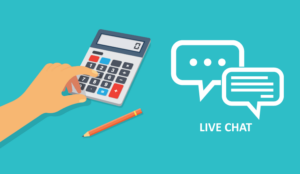Michael Harris of Playvox introduces eight metrics and discusses how they can be used on the live chat channel – while giving a benchmark for each.
A live chat system gives customers direct access to help with their issues, wherever in the world they currently are.
In addition, users can multitask while waiting for an agent’s response. The same can be said for the agents, who can search and gather supporting information all while chatting with a customer without having to mute them as they would during a phone conversation.
There is also an improvement in customer satisfaction (CSAT) when using live chat systems. A recent article by REVE Chat says live chat had a 79% impact on sales, revenue, and customer loyalty.
There are some companies that reply almost exclusively on a live chat system. Unity Technologies, a technology and gaming company, started with just email, but has a live chat platform bypassing a traditional call centre.
“When I started five years ago we didn’t even have a web form; it was literally just email,” said Angie Cantwell, Head of Customer Service at Unity.
“We’ve come a long way and you kind of have to go with what the users want and what they want is the support that is instant and helpful as possible.”
In live chat metrics, the scores are driven by agents who are friendly and responsive, and are getting the job done for the customer. But what are the key live chat metrics in live chat quality assurance?
Here are eight important metrics when it comes to evaluating a chat-focused agent.
1. First Response Time
Response time is critical and it’s important that a customer doesn’t spend any longer than a minute waiting for a response.
Research by dialogtech.com says 59% of customers are more likely to buy a product if a company responds in less than a minute. But that’s for a phone response, a chat solution is immediate so logically the numbers go up.
First Response Time ensures customers receive responses within an acceptable time. For the live chat centre, a company should arm agents with canned responses to answer the commonly asked customer questions in order to improve overall response time.
A company should also route the chats to the right agent across various departments, ensuring faster response delivery.
This is a valuable metric for live chat centres since it starts and sets the tone for other measured numbers like resolution, average handle time and quantity of calls.
- Calculating Live Chat Metric: Average response time = Total time taken to respond during the selected time period divided by the number of responses in the selected time period.
- Live Chat Benchmark: 80% of chats are answered within 40 seconds. (Source: Call Centre Helper.)
- First Response Time: 40 seconds
2. First Contact Resolution (FCR)
With live chat being an immediate process, it’s important to get the conversation started on the right foot with a friendly and proper introduction. From there, an agent can answer the customer’s questions and resolve any issues during that live chat.
First Contact Resolution is a critical live chat metric for contact centres to measure customer satisfaction. This metric measures what percent of the time agents are solving customer’s issues in a live chat session. Obviously, if the FCR rate is high, it means customer satisfaction is high.
Making First Contact Resolution a priority for live chat metrics will avoid repeat customers and keep the flow going.
- Calculating Live Chat Metric: For gross FCR: Number of contacts resolved initially ÷ All incoming contacts. For net FCR: Number of contacts resolved initially ÷ (All incoming contacts – Contacts that cannot be resolved at level one)
- Live Chat Benchmark: The industry standard is between 70 and 75% for FCR. (Source: Call Centre Helper.)
3. Average Handle Time (AHT)
This is a key metric regardless of the channel, whether it be live chat or phone. But the main difference between the two is that a phone call probably takes less time.
Staying on a chat, despite the immediate response rate, can take an average of 10 minutes. Of course, the total duration of the chat depends entirely on the industry and/or the skills of the agent.
At Unity, Cantwell said an average chat can last eight minutes.
So measuring an agent’s AHT can enforce a quick and compact answer to any customer’s issues. A lower AHT could mean two things, one being a quick agent has a great skill set and is a pro at handling customers with care. The second could mean the agent is rushing through a chat and not doing the job of solving the issue.
That’s a major reason why Average Handle Time is arguably the most important live chat metric.
4. Agent Utilization Rate
The agent utilization rate may be an “under-the-radar” metric, but it’s valuable nonetheless. This live chat metric is the measure of how work time is being used.
This KPI reveals the percentage of time that agents are spending in live chats, wrap-up, and other productive functions, as opposed to in “away” mode or offline.
- Calculating Live Chat Metric: Take the average number of calls handled by an agent in a month and multiply it by average call handle time in minutes. That number is divided by average number of days worked in a month multiplied by the number of hours worked in a day.
- Live Chat Benchmark: MetricNet’s benchmarking database shows the average agent utilization for service desks worldwide is about 48 percent. (Source: MetricNet.)
5. Number of Live Chats
The total number of live chats per day is a metric that coincides with Average Handle Time and the Agent Utilization rate.
Tracking the number of live chats is an important metric in measuring an agent’s performance numbers and is critical in the evaluation process.
It’s crucial to monitor the total number of live chats to find out how many chats were assigned to the agents, how many chats have been resolved, and how many are still pending.
- Live Chat Benchmark: The standard guideline for live chats is 274 chats per agent per month which averages to 13.7 per day. (Source: Acquire.io)
6. Customer Satisfaction (CSAT)
Of course, CSAT is a mainstay when it comes to contact centre metrics for all communication channels. Typically, these scores are determined through customer surveys.
The agent should always encourage customers to share their experience through your post-communication survey.
By having agents promote a customer survey you will receive consistent feedback. If agents don’t encourage a customer to take the survey, it could lead to an unbalanced score where only customers who have a great experience — or worse, a bad experience — complete the survey.
If some live chat agents are generating high satisfaction levels then it’s a big positive for the company. If others are not, then maybe it’s time for them to receive additional training or coaching.
- Calculating Live Chat Metric: CSAT score is the average score of satisfied responses (the metric focuses on the two highest values) that indicates the number of clients willing to continue doing business with a particular company.
- Live Chat Benchmark: The average score between 2015 and 2019 is between 81 and 87%. (Source: Comm100.)
7. Net Promoter Score (NPS)
NPS may seem in close proximity to CSAT but NPS measures the loyalty between customers and the company.
NPS gives quick feedback and usually goes off a 0 to 10 scale where customers rank how likely they would be to recommend a company. NPS eliminates doubts about your company by asking one simple question.
- Calculating Live Chat Metric: To calculate NPS and using a 0-10 score, organize responses into Detractors (0-6), Passives (7-8), and Promoters (9-10). Then, subtract the percentage of Detractors from the percentage of Promoters to determine your overall Net Promoter Score.
- Live Chat Benchmark: It depends and varies for each industry, but a plus-50% promoters over detractors is a solid live chat score. (Source: Wootric.)
8. Quantity of Live Chats
This is a metric more for the team leaders to keep an eye on as opposed to the individual agent.
Keeping tabs on the number of live chats a department receives can help understand the flow of the support system along with the overall load on the system.
It can tell you during which days of the week and times of the day you can expect a surge in live chat volume. This will help you efficiently allocate agents and resources to handle peak times.

Michael Harris
- Calculating Live Chat Metric: Take the number of website visitors per day divided by the percentage of visitors requesting chats and the abandonment rate percentage. For example, 7,000 website visitors per day with 20% requesting chats and 80% abandonment rate would amount to 1,400 chat requests per day with a live chat volume of 280 per day.
- Live Chat Benchmark: This depends on the size of the company’s live chat centre. A company with 6-10 agents averages 6,427 live chats per month. One with more than 50 agents averages 38,075 per month. (Source: Comm100.)
Author: Playvox
Published On: 4th Sep 2020 - Last modified: 28th Apr 2025
Read more about - Guest Blogs, Playvox













